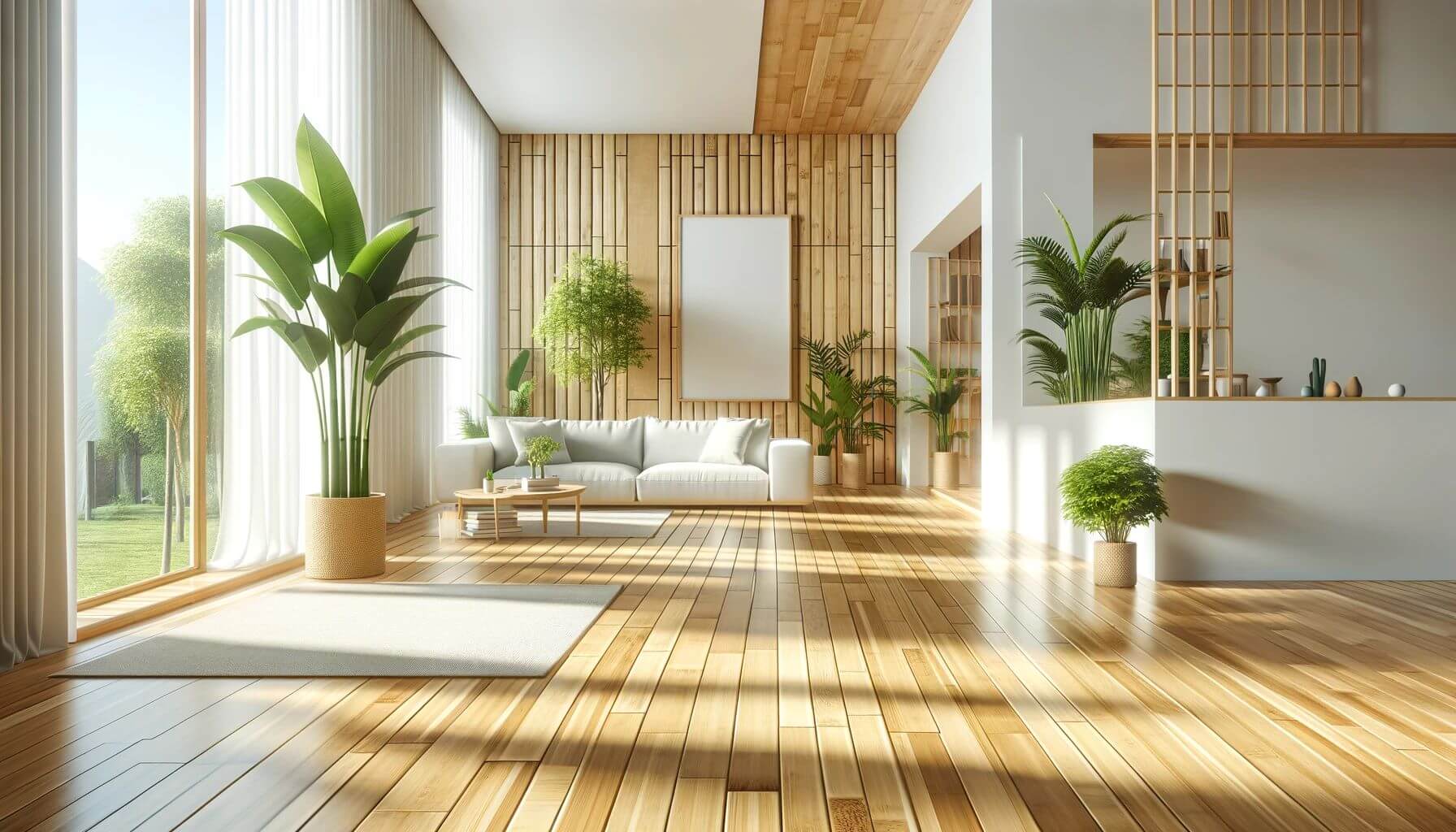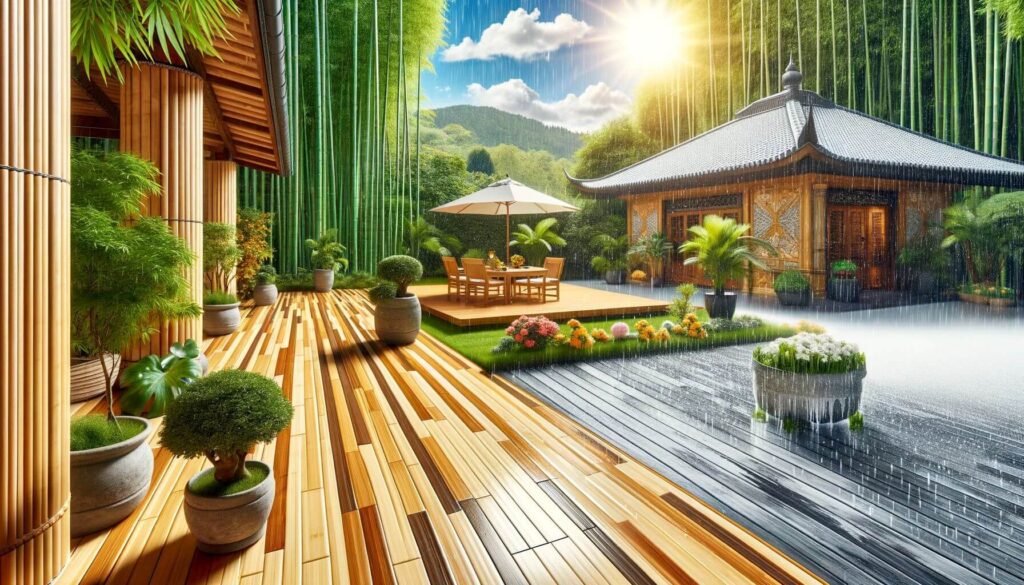
Transform your outdoor living space with bamboo flooring – a revolutionary choice that combines sustainability with unmatched durability. This in-depth guide explores the compelling reasons why homeowners and designers increasingly turn to bamboo for their patio needs.
Natural Beauty Meets Modern Design
The aesthetic appeal of bamboo flooring transcends traditional outdoor materials, offering a sophisticated blend of natural charm and contemporary elegance. The distinctive grain patterns create visual interest while maintaining a clean, modern appearance that enhances any patio design. Each bamboo board tells its own story through unique striations and color variations.
When properly finished, it develops a rich patina over time, adding character without compromising structural integrity. The natural color variations range from light honey tones to deeper caramel hues, providing designers with a versatile palette for creating stunning outdoor spaces. Many homeowners find that these natural variations help mask minor wear and tear, maintaining the patio’s beauty even with heavy foot traffic.
The material’s inherent visual texture adds depth to patio designs, creating an organic flow between indoor and outdoor areas. This seamless transition makes bamboo particularly appealing for homes with indoor-outdoor living concepts. The flooring’s natural luster reflects light beautifully, enhancing the patio’s ambiance during different times of the day.

Exceptional Environmental Benefits
Bamboo’s environmental credentials extend far beyond its rapid growth cycle. This remarkable grass reaches maturity in just 5-7 years, compared to the 20-120 years required for traditional hardwoods. This quick regeneration cycle makes bamboo one of the most sustainable choices available for environmentally conscious homeowners.
The plant’s extensive root system helps prevent soil erosion and can actually improve soil quality over time. During growth, bamboo releases approximately 35% more oxygen into the atmosphere than equivalent stands of trees. A single bamboo grove can remove up to 12 tons of carbon dioxide from the air annually, making it an excellent choice for reducing your carbon footprint.
Modern bamboo harvesting practices maintain the plant’s root system, allowing for continuous regeneration without the need for replanting. This sustainable approach preserves local ecosystems while providing a steady supply of premium flooring material. The minimal use of pesticides and fertilizers in bamboo cultivation further reduces its environmental impact, making it an ideal choice for eco-friendly patio designs.
Superior Durability for Outdoor Use

The natural density of bamboo fibers, combined with advanced manufacturing processes, creates flooring that outperforms many traditional hardwoods in durability tests. Quality bamboo flooring can achieve Janka hardness ratings exceeding 4,000 pounds-force, making it more resistant to dents and scratches than oak or maple. This exceptional hardness ensures your patio flooring maintains its beauty even under heavy use.
Advanced treatment processes enhance bamboo’s natural resistance to moisture and temperature fluctuations. The material undergoes specialized carbonization and sealing procedures that strengthen its cellular structure, resulting in flooring that maintains its integrity through seasonal changes. This makes bamboo particularly well-suited for outdoor applications where exposure to elements is a constant concern.
For patio installations, manufacturers often incorporate additional UV-resistant treatments and specialized sealants. These protective measures help prevent fading and deterioration from sun exposure, ensuring your outdoor flooring maintains its appearance year after year. The natural density of bamboo also helps resist moisture absorption, reducing the risk of warping or swelling during wet weather conditions.
Waterproof Performance

Modern bamboo flooring technology has revolutionized outdoor flooring with enhanced waterproof capabilities. Manufacturers achieve this through advanced treatment processes that penetrate deep into the bamboo’s fiber structure. Unlike traditional wood bamboo flooring, outdoor-specific variants feature specialized sealants that create an impermeable barrier against moisture.
The waterproof properties extend beyond surface protection. Strand-woven bamboo flooring demonstrates exceptional resistance to water absorption, making it ideal for outdoor spaces exposed to rain and humidity. The treatment process also prevents water from seeping between boards, protecting the subfloor and extending the overall lifespan of your patio installation.
For homeowners concerned about bamboo flooring over concrete, modern waterproof variants provide excellent protection against ground moisture. This makes them particularly suitable for patio installations where moisture migration from concrete substrates is a common concern.
Cost-Effective Investment
While affordable options abound, investing in premium quality outdoor bamboo flooring proves more economical in the long run. The initial bamboo floor cost may be comparable to other high-end materials, but the total cost of ownership tells a different story. The durability and low maintenance requirements significantly reduce ongoing expenses.
When evaluating the cost of bamboo flooring, consider its exceptional longevity. Quality outdoor bamboo installations can last decades with proper care, outperforming many traditional flooring options. The bamboo cost includes inherent value-adding features like natural insect resistance and weather durability, eliminating the need for expensive treatments and replacements.
The eco floor benefits of bamboo also translate to economic advantages. Many homeowners find that sustainable bamboo flooring adds significant value to their property, making it an attractive investment for future resale. The growing demand for eco-friendly home features further enhances this value proposition.
Low VOC Emissions
For environmentally conscious homeowners, bamboo floor low VOC characteristics represent a significant advantage. Modern manufacturing processes prioritize the use of eco-friendly adhesives and finishes, resulting in bamboo flooring VOC levels well below industry standards. This makes bamboo an excellent choice for creating healthy outdoor living spaces.
The natural properties of bamboo contribute to better air quality around your patio. Unlike some synthetic flooring materials, quality bamboo floors don’t off-gas harmful chemicals over time. This is particularly important for covered patio areas where air circulation may be limited.
Natural bamboo flooring manufacturers continue to innovate in this area, developing even lower VOC products without compromising durability or performance. This commitment to health-conscious manufacturing aligns with the growing demand for sustainable solutions.
Repair and Maintenance Simplicity of Bamboo Flooring

Maintaining bamboo floors requires minimal effort compared to traditional outdoor options. The bamboo flooring repair process is straightforward, allowing homeowners to address minor damage without professional intervention. For more significant issues, repair bamboo flooring services can restore the surface to its original condition.
Regular maintenance involves simple cleaning with mild solutions, and the durable finish resists staining and wear. When damage does occur, the repair bamboo floor process typically involves spot repairs rather than extensive replacements. This targeted approach saves both time and money while maintaining the patio’s aesthetic appeal.
The bamboo floor durability factor means repairs are generally less frequent than with other materials. When maintenance is needed, the bamboo flooring repair options available include spot sanding, refinishing, and board replacement, providing flexibility in addressing various types of damage.
Design Versatility
Modern flooring design options offer unprecedented flexibility for patio spaces. From traditional natural bamboo flooring to luxury bamboo flooring styles, the variety allows homeowners to create distinctive outdoor environments. The bamboo tiles design possibilities extend beyond conventional plank formats, enabling creative pattern installations.
Contemporary bamboo flooring ideas incorporate varied textures and finishes that complement modern architectural styles. The bamboo floor design options include wire-brushed surfaces, hand-scraped textures, and smooth finishes that showcase the material’s natural beauty. These design elements create homes with bamboo floors that stand out for their unique character.
For those exploring modern flooring, manufacturers offer innovative color treatments that maintain the material’s natural grain patterns. Whether choosing eco bamboo flooring in its natural state or stained flooring for a specific aesthetic, the results consistently impress.
Outdoor Durability Factors
When considering its durability for outdoor applications, several factors set this material apart. The environmental impact extends to its performance in challenging conditions. Unlike conventional wood bamboo flooring, outdoor variants feature enhanced protection against UV exposure and weather fluctuations.
Outdoor bamboo flooring must meet stringent requirements for durability and weather resistance. The benefits of bamboo flooring in exterior applications include superior dimensional stability and resistance to warping. This makes it over concrete particularly effective for patio installations.
The bamboo floors durability factor becomes especially apparent in high-traffic areas. Through advanced manufacturing processes, bambu flooring (alternative spelling often used) maintains its structural integrity and appearance even under heavy use conditions.
Installation Flexibility
Installing bamboo flooring on concrete patios demonstrates the material’s versatility. Modern bamboo options include various installation methods suitable for different subfloor conditions. Whether choosing bamboo flooring on concrete or other substrates, proper installation ensures optimal performance.
The installation process accommodates various bamboo wooden floors configurations, from traditional nail-down methods to floating floor systems. This flexibility makes bamboo floorings adaptable to different patio designs and structural requirements.
For those wondering why bamboo flooring is an ideal choice for patios, the installation versatility plays a crucial role. The material’s stability and dimensional consistency facilitate smooth installations over various subfloor types.
Sustainable Choice Impact of Natural Bamboo Flooring
Why is bamboo considered a green flooring option? The answer lies in its remarkable sustainability profile. Green bamboo flooring represents more than just an eco-friendly choice; it embodies a commitment to environmental stewardship. The bamboo flooring sustainable characteristics include rapid renewability and minimal environmental impact during production.
Eco floor options often prioritize sustainability at the expense of performance, but sustainable bamboo flooring delivers both. The environmental benefits extend throughout the product lifecycle, from cultivation to eventual biodegradation.
When evaluating eco friendly bamboo flooring options, consider the entire supply chain. The best bamboo flooring manufacturers maintain strict environmental standards while producing high-quality materials suitable for outdoor applications.
Comparative Value
Teak vs bamboo comparisons often favor bamboo for outdoor applications. While both materials offer excellent durability, bamboo options provide superior value through lower costs and easier maintenance. Affordable bamboo flooring doesn’t compromise on quality, making it an attractive alternative to traditional hardwoods.
For waterproof bamboo flooring applications, the material’s natural resistance to moisture complements manufactured protective features. This dual-layer protection ensures longevity in outdoor environments while maintaining aesthetic appeal.
Professional Care and Maintenance
Maintaining bamboo floors requires specific knowledge of the material’s characteristics. Regular cleaning with appropriate solutions prevents damage while preserving the floor’s natural beauty. For luxury bamboo flooring installations, professional maintenance services can extend the flooring’s lifespan significantly.
The bamboo glooring (common misspelling found in searches) care routine differs from traditional hardwood maintenance. Understanding these differences helps homeowners protect their investment and maintain optimal appearance over time.
Regional Adaptation
When searching for “bamboo flooring near me,” consider local climate conditions and their impact on material selection. Different regions require specific flooring options suited to their environmental challenges. Local suppliers often stock variants optimized for regional weather patterns.
Future-Focused Investment

As sustainability becomes increasingly important, bamboo sustainable practices continue to evolve. The industry’s commitment to eco-friendly manufacturing processes ensures that bamboo remains at the forefront of green building materials.
The benefits extend beyond environmental considerations to include:
- Long-term durability supporting sustainable resource use
- Improved manufacturing techniques reducing environmental impact
- Enhanced performance characteristics through technological innovation
- Growing market acceptance increasing property value
- Continued development of eco floor solutions
Quality Assurance
When selecting bamboo floorin (common search variation), focus on manufacturers with proven track records. Quality indicators include:
- Comprehensive warranty coverage
- Third-party certification of environmental claims
- Consistent manufacturing standards
- Proven performance in outdoor applications
- Professional installation support.



